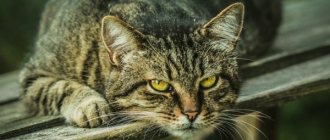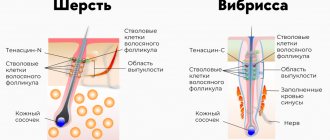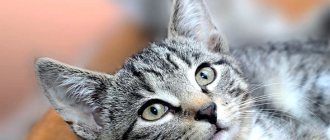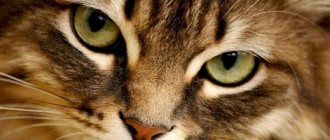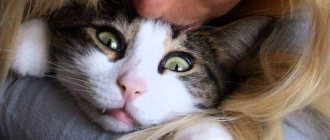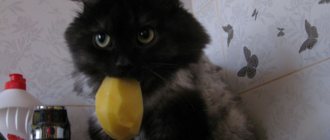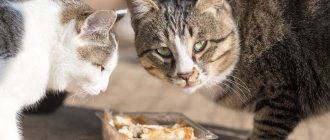Why do you think cats can't fish?
- Is it possible to feed?
- Castrated
- Sterilized
- Which one is acceptable to give?
- Raw
- Boiled
- Salty
- Caviar and milk
- Special feed
- What else should I feed?
Cat owners often prefer to feed their pets fish, believing that such a diet is natural for representatives of the cat family. However, experts say that this product should not be given to spayed and neutered animals. Because it can cause severe health problems.
Dry pollock meat
To determine the juiciness of a fish, you need to determine its water-holding capacity. This indicator is very important. It indicates the process of protein denaturation and the quality of muscle tissue. The fresher the fish and the less the fillet has been exposed to temperature fluctuations, the higher this indicator.
According to the quality requirements for fish products, the water-holding capacity must be at least 50%. Experts have found that the following brands of pollock meet these standards:
- Polar;
- Flipper;
- "Bay of Plenty";
- "Atlantic";
- "VkusVill"
- "Flanderre";
- "Okeanrybflot";
- "Sakhalin fish"
These varieties of fish can be considered the most juicy.
Is it possible to feed?
However, eating fish can negatively affect your health. Veterinarians believe that this product, especially if fed to pets frequently and in large quantities, can lead to obesity, kidney problems and the rapid development of urolithiasis. This is especially true for spayed and neutered pets.
Castrated
Castration of a cat leads to the fact that the animal’s hormonal system weakens and becomes susceptible to various pathologies. Therefore, metabolism slows down.
Both owners and veterinarians note that neutered cats have an increased appetite and a risk of developing obesity. The rapid growth of adipose tissue contributes to fluid retention in the body, urine becomes more concentrated, and urination is impaired.
Fish contains large quantities of magnesium, potassium and phosphorus. With reduced hormonal levels and obesity, it is difficult for cats to get rid of excess of these substances in the body. Sand and stones appear in the urinary tract, and urolithiasis develops. Excess iodine, which is also found in fish products, leads to disturbances in the endocrine system.
Sterilized
Sterilized cats, like castrated cats, have hormonal imbalances and may experience similar problems. Therefore, it is recommended that they be given only specialized food that is balanced in the content of microelements and does not lead to obesity.
In addition, it is undesirable to feed cats of any breed with fish products if they have the following diseases and conditions:
- proneness to allergies;
- diagnosed hypertension;
- digestive problems;
- individual intolerance to microelements included in this product.
A package of pollock fillets contains more ice than fish
There are technical regulations according to which the ice crust content in fish fillets should be no more than 5%. Experts found that thirteen brands of pollock meet this standard, and two do not.
It’s better not to neglect hygiene: what happens if you don’t brush your teeth for more than a day?
In Norway they are going to build the world's first tunnel in the rock for the passage of ships
Long neck and good blood pressure: giraffe gene can cure hypertension
However, it is important to take one detail into account. The actual net weight of the fish after defrosting must be equal to the declared fillet weight indicated on the packaging. All fifteen brands of pollock met this standard, including those where the ice crust content exceeded the norm. This suggests that the buyer is not being shortchanged. He pays for the weight of the fish that was declared.
A thick crust of ice is not a disadvantage. It protects the fillet from spoilage and loss of liquid. A large amount of ice glaze only affects the duration of defrosting, but does not affect the taste of pollock.
Which one is acceptable to give?
Most experts agree that if you give cats fish, it should be salmon, tuna, salmon, trout, sardine or mackerel .
The carcasses should be gutted, boiled in unsalted water, cooled to room temperature and all bones removed. Only in this form can you give fish to cats.
For 1 dose, 80-100 g is enough for a pet, and a pet should be treated to this product no more than once a week.
You can cook buckwheat, rice or other cereals using the remaining fish broth.
Raw
Both cat owners and veterinarians agree that feeding raw fish to your pets is dangerous to health. There is a high risk of animal infection with helminths and opisthorchiasis. Treatment will require medication, which can negatively affect the cat’s condition.
In addition, raw fish may contain heavy metal salts, antibiotics and other harmful substances that can cause severe allergic reactions. Therefore, feeding cats raw fish should be avoided.
Boiled
The best option for introducing fish into a cat’s diet is to give it boiled. In this case, it should be freed from bones, and the fillet should be chopped or wiped.
You can mix this minced meat with cereals, such as buckwheat or rice porridge. In this case, the cat will receive a complete meal containing both proteins and carbohydrates.
Veterinarians recommend pampering your pets with fish products no more than once a week. It is advisable to set a day for this, for example Sunday.
Salty
Salted fish products are also not suitable for the cat's menu. Salt entering the pet's body causes fluid retention. This can lead to high blood pressure and problems with urination.
Food containing fish
In low-quality products it is used as a flavoring agent, but in premium foods it is used as the main source of protein. The main advantage of ready-made mixtures is safety: they do not contain bones or parasites, and the balance of microelements is maintained.
Hill's
Dietary food based on ocean fish helps support the functioning of the urinary system in animals with diseased kidneys and impaired metabolism. In addition to vitamins, amino acids, proteins and carbohydrates, the composition contains ingredients that prevent the development of inflammatory processes.
Hill's diet food with fish.
Farmina
The sources of protein in this food are herring and chicken. The product contains antioxidants and is available with oats and in a grain-free version. It is well absorbed and does not cause allergic reactions.
Farmina food does not cause allergies.
Mealfeel
Complete food contains poultry and salmon in equal parts.
The product contains a lot of legumes, and rice is used as an additional source of carbohydrates. The food of this Russian brand is produced for pets with various digestive characteristics, including sensitive stomachs, fast or slow metabolism.
Mealfeel with salmon for delicate stomachs.
Wellkiss
In the line of these Belgian foods, the salmon product has a high fish content. It can be included in the diet of both active animals and those requiring additional care when recovering from surgery or injury. The disadvantages of the product are inaccuracy in the listing of ingredients by the manufacturer and high cost.
Wellkiss food for active animals.
Grandin
The food contains dried cod, sardine and conger eel and Norwegian salmon oil.
The product is available in different flavors and is a source of high-quality protein. The composition does not include cereal ingredients, but a herbal complex has been added, which has a positive effect on the functioning of the digestive, excretory and circulatory systems.
Special feed
Food manufacturers produce special diets for complete and balanced nutrition of cats:
- Monge - in most cases these are monoprotein pates made from beef, chicken, and duck. However, among them you can find canned tuna, vegetables and shrimp. They are safe and designed specifically for feeding sterilized animals.
- Carnilove is a dry food based on lamb, wild boar and poultry. However, the manufacturer also produces salmon-flavored mixtures, a fish that is allowed to be eaten by castrated cats.
- Royal Canin is one of the most popular pet food manufacturers, producing mainly dry food. They are well balanced and contain special additives for the prevention of urolithiasis.
All food can be purchased both in pet stores and on thematic Internet resources. However, before choosing such canned food for your pet, you need to consult a veterinarian.
What else should I feed?
In order for a spayed or neutered cat to remain healthy, it is important to properly organize its diet. It is necessary to exclude foods such as milk and all fermented milk products, especially in adult animals.
Do not feed your pets fatty meat, lard, smoked meats, unheat-treated chicken, beef liver, or potatoes in any form.
Veterinarians recommend giving your pets special balanced food , which can be bought in stores. In addition, you can include boiled chicken and turkey, offal (chicken heart, chicken gizzards), vegetables - carrots, white cabbage, zucchini and cereal porridges made from rice and buckwheat - in your cat's diet.
Despite the fact that fish products are healthy for humans and are part of a healthy diet, their consumption is undesirable for felines. This is especially true for individuals who have undergone castration and sterilization.
You can give such pets fish only in boiled form and no more than once a week. At the first signs of obesity, problems with urination or urolithiasis, this product should be discarded.
Cats have no place here
Remember from “Ivan Vasilyevich, changing his profession”: “Black caviar, red caviar, overseas caviar, eggplant”? The modern consumer’s attitude towards pollock is approximately the same as 500 years ago – towards black caviar. If there is a lot of product, then few people are interested in it. And only then, with hindsight, does the consumer understand: “What we have, we don’t keep, and when we lose it, we cry.” Text: Anton Belykh.
The stereotype “pollock is a fish for cats” was born around the early 80s, when a kilogram of this fish cost 35 kopecks in the Soviet Union. About six to eight times cheaper than a kilogram of meat. The Chairman of the Council of Ministers of those years, Alexey Kosygin, believed that fish was the health of the Soviet people, and forbade any talk about increasing prices for fish products, including pollock.
In the mid-eighties, catches of this fish of the cod family in the USSR reached seven million tons, which is more than the total catch of Russian fishermen over the past year. At the very beginning of the nineties, when a severe food crisis broke out in the country, pollock actually remained the only fish that could be bought in the store. Then there was no time for cats; pollock really saved people from hunger. By the way, largely thanks to the crisis, many have tasted its excellent taste. I remembered one story that the author of these lines witnessed.
The word “pollock” is borrowed and has Far Eastern origin. Linguists have differing opinions here. Some believe that this is a Japanese name from the word “mentai” and even cite the corresponding hieroglyph; others believe that the Japanese themselves borrowed this word from the Chinese, and they, in turn, from the Koreans or Vietnamese. In many dictionaries, this word is indicated specifically as Vietnamese, and, perhaps, initially it could have consisted of two words: “min” and “thai”. It is interesting that in Russia there is also taimen, the name of which also contains the root “tai”, although it is known that “taimen” is the Estonian-Finnish name for trout. But why pollock is called pollock largely remains a mystery.
In 1991, the Germans, filled with gratitude for the unification of the GDR and the Federal Republic of Germany, decided to collect humanitarian aid and send it to Moscow schools. They brought a whole truck with clothes, as well as sausage and other products. Our people remained hospitable in any situation, and the teachers decided to at least adequately feed the German colleagues who accompanied this humanitarian aid. We chipped in, sent a messenger to the grocery store, and there was only pollock. No meat, no other fish, just empty counters. There was nothing to do, we bought pollock, made a batter from flour and eggs, added seasonings, fried pollock in this batter in the school cafeteria, and served it to the Germans. They asked in admiration what kind of fish was so tasty; they had never tried anything like it. When they found out it was pollock, they were surprised. The fish is familiar to them, they just didn’t know that it could be so tasty.
Pragmatic Germans really know a lot about pollock. Germany buys frozen pollock from Russia, China and the USA, processes it and sells it as fillets to other EU countries. Pollock is also caught in small quantities by German fishermen, although this is the so-called Atlantic subspecies. Pacific pollock, which is common in the Seas of Okhotsk, Bering and Japan, is considered classic. Among marine commercial species, pollock is considered a long-liver: this fish can live up to 20 years, grow up to a meter in length and reach five kilograms in weight. However, most of the catch is fish up to 50 cm long and weighing about a kilogram.
Pollock lives at a depth of 200-300 meters. When migrating, it can descend to 600-700 meters; during spawning, on the contrary, it rises closer to the surface of the ocean. During the “childhood” age, it feeds mainly on plankton and small crustaceans. Having matured, it becomes a predator and dines on small fish like capelin and smelt. Pollock matures at 3-4 years; females can spawn even at sub-zero temperatures. Pollock generally likes cold water with a temperature no higher than +10°C. Pollock also has very large and beautiful eyes, if, of course, such a compliment can be addressed to a fish.
Pollock is extremely beneficial for health, which is recognized by doctors and nutritionists. 100 grams of pollock fillet contains 16% protein and 1% fat, no carbohydrates at all. Its calorie content is extremely low: the same 100 grams contain 72 kilocalories. If you're watching your weight, burning this amount of calories will require about 15 minutes of walking at an average pace or five to seven minutes of intense morning exercise.
The lack of carbohydrates makes pollock an ideal product for people suffering from diabetes or simply being overweight, which leads to diabetes with a confident gait. A large amount of vitamin A is a good prevention of cancer. For example, doctors often recommend pollock to smokers because it reduces the likelihood of getting lung cancer. Although this is not a reason to continue smoking, of course.
Pollock is very useful for pregnant women and nursing mothers. This fish contains a lot of iodine, which is important for the thyroid gland, which suffers during pregnancy and lactation. From eight months, pollock can be included in the diet of babies, for example, by adding it to cereals and purees. Manufacturers of canned baby food have been adding cod fish meat to their products for a long time. Pollock is included in the approved set of products for preschool educational institutions, that is, kindergartens.
The beneficial properties of pollock include the fact that the meat of this fish reduces cholesterol levels and improves brain activity. Pollock contains a large amount of polyunsaturated acids omega-3 and omega-6. At the same time, pollock should be consumed with caution by people suffering from stomach ulcers or kidney diseases: after all, any sea fish contains a relatively significant percentage of salt.
Special mention should be made of pollock caviar. It contains exactly the same amount of vitamins E and C as sturgeon and salmon caviar. These vitamins are known to have a good effect on the functioning of the nervous system, improve blood quality, in particular, promote rapid healing of wounds. Sodium, which is part of pollock caviar, helps maintain blood pressure at the desired level. Nicotinic acid, which is also abundant in this caviar, improves cerebral circulation, which has a good effect on memory and thinking.
Finally, two pleasant moments for those who love a classic feast. After drinking alcohol, pollock caviar helps restore the body's reserves of vitamin B1, or thiamine. 100 grams of pollock caviar contains 1.5 mg of thiamine. The second point has nothing to do with benefits, it’s just that pollock caviar is a great appetizer. It can be spread on a sandwich or on hard-boiled eggs, or served with boiled potatoes. The taste sensations will be at the highest level, and the price of 60-70 rubles per jar makes this product as affordable as possible. Cheaper - just for free.
In Japan, in Ibaraki Prefecture, there is a “Pollock Park”, where all guests are offered to try or buy products made from pollock roe, or rather, from the variety that the Japanese call “mentaiko”. This is marinated pollock caviar with various spices that give it a special spiciness and pungency. At Pollock Park you can try chicken wings in pollock sauce, there is even mentaiko flavored ice cream, not to mention traditional rice, which the Japanese simply mix with pollock caviar. In addition to “mentaiko”, the Japanese also highly value “tarako” - salted pollock caviar in yastyk, that is, in a natural shell. It tastes similar to the one we sell in jars.
In other words, in terms of its properties, pollock is not only not inferior to more expensive types of fish, but in many ways superior to them. The main problem with pollock is its lack of culinary popularity. Our chefs and restaurateurs have not yet thoroughly tried pollock dishes, unlike their foreign colleagues. For example, Asian restaurants, of which we have a great many, could adopt the Chinese recipe for pollock in orange sauce. In German establishments, pollock is excellently baked in a pot with pumpkin and sour cream. Italian fashionable chefs prepare spaghetti with pollock caviar as a delicacy. In restaurants of Caucasian cuisine, which are traditionally highly rated in our country, you can serve pollock with a marinade with adjika: it turns out spicy and spicy in a southern way.
What kind of fish can you feed cats and why do they love it? Is it given to castrated cats?
People strongly associate cats with fish. A cat with a fish bone in its paws is a typical hero of comics and funny pictures dedicated to these animals. Felines really love fish, but few people have thought about what causes such love. Is this product suitable for a cat's diet? What kind of fish can be given to tailed pets? How often can fish dishes be included in a pet's menu? Why shouldn't cats be treated to raw fish? Is it true that whiting, capelin and other species of these vertebrate aquatic inhabitants are prohibited for castrated and sterilized cats?
Do cats need fish?
The benefits of this product for cats are difficult to overestimate. Fish is well digestible both boiled and raw due to its low connective tissue content. It contains essential amino acids (2,6-diaminohexane, aromatic alpha amino acid) in the correct proportion, as well as vitamins and mineral components (iodine, phosphorus, magnesium, calcium, manganese, zinc, fluorine, copper, etc.), which It is from this that they are well absorbed.
The fat-soluble retinol, tocopherol, phylloquinone and cholecalciferol found in fish are not easily obtained from other foods. These components have a beneficial effect on the functioning of internal organs, for example, they normalize blood pressure and blood sugar levels. During the cooking process, fish broth is saturated with extractive components that improve digestion.
Another undoubted advantage is the high content of polyunsaturated fatty acids, which are well absorbed by the body due to their low melting point. They have a positive effect on the functioning of the heart, the condition of the bone system and skin, improve vision, and strengthen the walls of blood vessels.
Not all fish contains a lot of fat. Thus, in low-fat species (freshwater perch, pike, cod) their share is only 3%, in medium-fat species (sea bass, sprat, carp, catfish) - about 8%, in fatty species (mackerel, saury, whitefish, sturgeon) – 8–20%, in particularly fatty foods (salmon, herring, eel) – 34%.
What fish can be included in a cat's diet and how often?
A kitten or an adult animal can only be fed with inhabitants of the seas and oceans. Give preference to those who do not accumulate heavy metals:
- salmon;
- side;
- herring;
- sardine;
- heku;
- anchovy;
- catfish;
- tilapia;
- haddock;
- cod;
- flounder;
- whiting.
The most delicious, healthy and safe for these animals are salmon growing in free conditions:
- pink salmon;
- salmon;
- chum salmon;
- trout;
- red salmon;
- Chinook;
- coho salmon;
- brown trout;
- omul;
- whitefish;
- loach;
- taimen;
- grayling;
- lenok.
It is recommended to give lean fish to older pets and overweight cats:
- European flounder;
- halibut;
- cod;
- hake;
- haddock.
You cannot feed these animals with capelin, sprat, blue whiting, pollock and saury. There is practically no benefit to them. In addition, pollock is considered the most dangerous fish in terms of the likelihood of helminthiasis. If it is impossible to pamper your tailed pet with noble fish, you should give it preparations with omega-3 and omega-6 polyunsaturated fatty acids, for example “Nutricoat” or “Brewers Yeast”.
Before you treat your pet to a fish dish, you need to:
- Remove head, fins and scales.
- Boil. If you plan to feed your animal raw fish (some veterinarians insist on cats eating non-thermally treated cod fish, which do not have parasites), it must be frozen for 7 days. When boiling, do not salt and pepper the fish. During cooking, you should not use not only salt and pepper, but also any seasonings. How long does it take to cook fish? It depends on its type and size. It must be boiled until fully cooked.
- Break the cooked fish pulp into pieces and remove all bones.
- Cool to room temperature.
You cannot feed your pet fish dishes every day. They are a delicacy, not an everyday food, and even if your tailed pet eats such food with appetite, it should be given to him no more than once a week.
Why can't you give cats salted, smoked or fried fish?
It’s clear with blue whiting, capelin and other types of fish prohibited for these animals, but what about salted, smoked and fried foods? Is it possible to treat them to a pet? Veterinarians are unanimous on this issue. Such food should not be in a cat's diet, even as a rare treat. Salt, and when salting and smoking fish it is used in excess, is extremely harmful to cats. Salty food provokes the appearance of stones in the organs of the urinary system.
Smoked foods have a detrimental effect on the liver of cats. Harmful substances formed during their preparation lead to the development of cancer and corrode the gastric mucosa. The same goes for fried fish. In addition, it contains a lot of “bad” fat, which puts a lot of stress on the liver.
Fillet is subjected to repeated freezing and thawing
Pollock meat is lean. If the fillet is re-frozen, it becomes excessively dry and tough. Experts have determined the percentage of deep dehydration of fish. This indicator indicates whether the fillet has been refrozen.
In thirteen pollock varieties, deep dehydration did not exceed 10% of the total mass. This indicator is the norm. This means that they were not defrosted during transportation. Only in two brands (Fine Life and Flipper) did deep dehydration exceed the norm several times.
Reduces high sugar and bad cholesterol: new properties of avocado have been discovered
Astronomers look at a “cosmic jellyfish” in a galaxy cluster for the first time
Shading from the scorching sun and rainwater: an eco-friendly hotel in Colorado
Why are fish dishes contraindicated for neutered pets?
In castrated animals, which, unlike sterilized ones, have lost their ovaries or testes, the hormonal system and metabolism change. After the procedure to deprive them of reproductive function, they automatically fall into the risk group for kidney and endocrine diseases. The components found in fish negatively affect the functioning of the relevant organs, so eating fish by cats after castration is not recommended.
The absorption of elements contained in these products is inhibited, and a tendency to accumulate them develops. Accumulating in the body of castrated animals, they lead to the appearance of stones in the organs of the urinary system. Despite the enormous health benefits for cats, fish dishes should be offered to them extremely rarely.
Castration imposes additional restrictions on the nutrition of representatives of this family, especially on those foods that can provoke the formation of stones in the organs of the urinary system. This point should be taken into account when deciding to get a kitten and accustoming it to natural food.
How to cook?
You can treat your pet to boiled cod.
There are various recipes for fish treats for cats. Boiled cod is prepared as follows:
- Place the prepared fillet into boiling water.
- Cook the fish for 4-6 minutes. until soft.
- Cool.
Pollock for cats should be boiled or thoroughly frozen for consumption raw. Kittens and pregnant cats can also make dishes from this type of fish. It is better for them to cook pollock. Heat-treated fillet is easier for the cat's stomach to digest. But giving this fish is often not recommended, since excess minerals are difficult to absorb by the body.
According to veterinarians, it is not advisable to give salted fish to cats, since the salt it contains significantly exceeds the permissible daily allowance for a cat.
Why should neutered cats not eat fish?
Most veterinarians, after castration surgery, warn animal owners that from now on fish should be completely excluded from their pets’ diet, because its consumption has an extremely detrimental effect on the cat’s health. This is explained primarily by the fact that the fish menu is not healthy for all cats without exception, because in the wild this diet is natural only for some species of felines. The rest hunt mainly for small animals and birds, and in general they don’t like to go into water.
In the wild, only a few cats eat fish.
After surgery, during which the reproductive organs are removed, the hormonal levels change dramatically. Metabolic processes slow down and there are not enough necessary hormones for their normal regulation. Due to overeating (castrati usually have an excellent appetite), adipose tissue is deposited, which retains water. The functioning of some internal organs (pancreas, liver) is also impaired. Infection at this moment with helminths contained in raw fish (river and lake) will be especially severe.
Protein foods make urine richer and more concentrated. The cat’s body copes much worse with removing excess magnesium, potassium and phosphorus salts contained in fish (especially sea fish) in increased quantities. The result is the deposition of phosphates and oxalates (sand and stones) in the urinary tract and, as a consequence, the development of urolithiasis. To top it all off, there is an even greater imbalance of the endocrine system due to disruption of the thyroid gland, caused by excess iodine in the body.
In sterilized animals, sexual function is preserved, but the level of hormones still changes; consumption of fish is also undesirable for them.
However, as a result of studies conducted in which phosphorus was additionally added to the cat's diet (in fairly large quantities), it turned out that this did not lead to the development of urolithiasis.
What else can neutered cats not do?
The following products must be excluded from the diet of castrated animals:
- fatty meat (pork);
- raw poultry meat (chicken);
- fermented milk products with high fat content (cottage cheese, cheese, sour cream, etc.) and whole milk;
- liver;
- smoked, as well as salty and spicy.
Cats should not eat smoked food
It is highly not recommended to feed cats with cheap, economy-class food, since in addition to preservatives, dyes and flavor enhancers, there are many more harmful components (heavy minerals and salts).
Once upon a time, we had a Siamese cat who was fed exclusively with boiled pollock. She didn’t admit anything else. She lived for more than 15 years and did not suffer from any illnesses.
Diet of a castrated cat
The menu for a cat after castration must be selected very carefully; it includes the following products:
- boiled lean poultry (chicken, turkey, etc.);
- offal (lung, heart, chicken gizzards, etc.);
- vegetables (carrots, cabbage, zucchini, etc.);
- porridge (rice, buckwheat, etc.).
When choosing factory-made feeds, you should give preference to products of at least a super premium class, and better yet holistic (Acana, Pro Plan, etc.), intended for castrated and sterilized animals.
